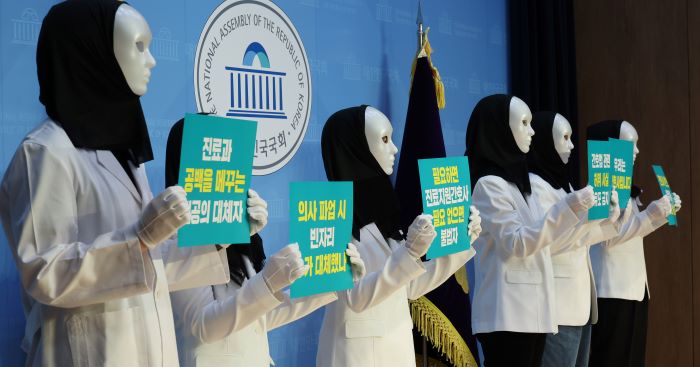
In a moment of camaraderie and resilience, nurses exchange high-fives during their transition between shifts at the negative pressure ward of Daegu Medical Center on May 11. This day marked a significant development as the government elevated the COVID-19 crisis level from “severe” to “alert,” highlighting the ongoing dedication and teamwork of healthcare professionals in the face of the pandemic. (Image courtesy of Yonhap)
SEOUL, May 17 (Korea Bizwire) —Nurses are protesting against President Yoon Seok-yeol’s veto of a controversial bill that would define the roles and responsibilities of nurses, expressing concerns about potential disruptions to the public healthcare system.
On Wednesday, the Korean Nurses Association (KNA) announced their intention to engage in a so-called “work-to-rule” campaign. They plan to refuse doctors’ orders for all kinds of illegal treatments and procedures under the current medical system, such as proxy prescriptions, proxy surgeries, proxy records, blood draws, ultrasound and electrocardiogram tests, arterial blood draws, dispensing of anti-cancer drugs, L-tube and T-tube exchanges, tracheal intubation, suturing, and entering surgical numbers.
While the nurses will not collectively refuse care, they will refrain from performing “non-nursing care,” a practice that some nurses, including physician assistants (PAs), have been involved in.
The association believes that this practice has become prevalent due to illegal orders from hospitals. They are also establishing an illegal treatment reporting center to collect cases.
Nationwide, the number of PA nurses, also known as “operating room nurses,” reportedly exceeds 10,000. They primarily assist in the operating room, with testing procedures, specimen requests, and emergencies, and they have partially taken over certain duties that were previously performed by doctors, blurring the lines of legality.
The PA nurse profession has experienced rapid growth since its inception in 2010, largely due to doctor shortages and the need to fulfill essential medical care. According to the Korea Hospital Nurses Association, the number of PAs increased by 43 percent from 3,353 in 2016 to 4,814 in 2019.
Despite their significant role in the medical field, PA nurses currently operate outside the bounds of the law, as they were introduced without a formal process. In contrast, physician assistants in the United States have been integrated into the medical system, but in Korea, their official inclusion has faced opposition from physician groups.
The Ministry of Health and Welfare acknowledges this situation and has committed to establishing a system to clarify and manage the scope of work for PA nurses in the Second Comprehensive Plan for Supporting Nursing Manpower, released on March 25.
Most PA nurses are employed in critical medical areas such as surgery and cardiothoracic surgery, which doctors tend to avoid. Consequently, depending on the extent of their participation, “work-to-rule” could potentially lead to disruptions such as surgery delays.
A survey conducted by the Korean Healthcare Workers’ Union among 288 PA nurses revealed that 93.4 percent of them reported performing duties typically carried out by physicians.

Emotions ran high as a participant tearfully concluded a poignant press conference organized by the Korea Nursing Association, fervently urging for the official enactment of the nursing law. The event took place in front of the presidential office in Yongsan, Seoul, on May 16. (Image courtesy of Yonhap)
It is not only PA nurses but also general nurses who might engage in a “compliance struggle,” potentially causing disruptions to the provision of healthcare services. A survey commissioned by Korea University’s Institute for Labor Issues and conducted by the Korean Healthcare Workers’ Union in January and February this year included 31,672 nurse members.
More than 40 percent of the respondents stated that nurses undertake procedures (44.9 percent), dressings (43.5 percent), and prescriptions (43.5 percent) in place of doctors.
However, it remains uncertain to what extent nurses will actually participate in collective action in a medical environment where doctors and nurses work together as a team. PA nurses, in particular, face challenges in joining collective action since they are part of medical departments rather than nursing departments.
While participation cannot be enforced, there is significant anger among nurses regarding the veto of the nursing law, according to a nursing association official. In a recent survey, over 98 percent of nurses expressed their belief that active collective action is necessary.
Given that the nurses’ collective action aims to uphold the law rather than violate it, the Ministry of Welfare has been unable to develop specific measures, according to Lim In-taek, head of the Healthcare Policy Division at the Welfare Ministry, during a briefing on Tuesday.
M. H. Lee (mhlee@koreabizwire.com)







